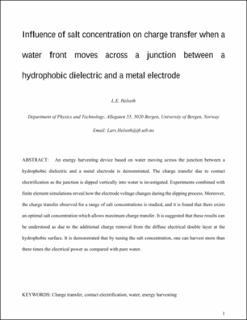Influence of Salt Concentration on Charge Transfer When a Water Front Moves across a Junction between a Hydrophobic Dielectric and a Metal Electrode
Journal article, Peer reviewed
Accepted version

View/
Date
2020Metadata
Show full item recordCollections
Abstract
An energy-harvesting device based on water moving across the junction between a hydrophobic dielectric and a metal electrode is demonstrated. The charge transfer due to contact electrification as the junction is dipped vertically into water is investigated. Experiments combined with finite element simulations reveal how the electrode voltage changes during the dipping process. Moreover, the charge transfer observed for a range of salt concentrations is studied, and it is found that there exists an optimal salt concentration which allows maximum charge transfer. It is suggested that these results can be understood because of the additional charge removal from the diffuse electrical double layer at the hydrophobic surface. It is demonstrated that by tuning the salt concentration, one can harvest more than 3 times the electrical power as compared with pure water.